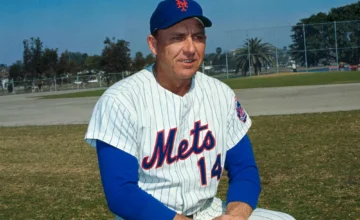It has been assumed for quite some time that the Mets would have traded one of their incumbent starting pitchers this offseason in exchange for a bat.
As things have played out thus far, no such trade has surfaced. This leaves the team with a surplus of starting pitchers, a problem that 29 other teams wish they had. So why trade away an effective starter (presumably Gee or Niese) for spare parts when they could use that surplus to their advantage by implementing a six man starting rotation?
There isn’t a Mets fan alive that isn’t afraid of Matt Harvey having a repeat of 2012 Stephen Strasburg, who was shut down as his team took an early postseason exit. Sandy Alderson has already said that the team will explore options such as skipping starts and delaying the start of his season to keep him fresh for a potential postseason run. But the simplest option is staring us all right in the face: 162 games, 6 starters, 27 starts each.
Ideally, you would space out the 3 hard throwing righties (Harvey, deGrom, Wheeler) with the finesse guys (Gee, Colón, and the lone southpaw Niese) to keep opposing teams off balance. This rotation would allow flexibility be it for rainouts, the inevitable makeup doubleheader, and the minor injuries that Niese and Colón will undoubtedly endure and (God forbid) tired arm for Harvey. The six man rotation allows starters to skip a start if needed without having to make a roster transaction.
There are concerns about young Jacob deGrom having a spike in innings, especially since he only converted to pitching late in his collegiate career. 27 starts instead of 33 seems like a good way to keep the young phenom both healthy and effective. As for Zack Wheeler, no one doubts his arm or his stuff. But all too often in 2014, we watched his pitch count approach the dreaded 100 in the 5th, 4th, even third inning. This leads us to the true beauty of the 6 man rotation: it frees us from the chains of that dreaded number. Because anyone who has watched baseball in the 21st Century knows that if a pitcher throws over 100 pitches, his arm is likely to burst into flames.
Pitch counts are such a prominent part of the game these days that they’re displayed on multiple scoreboards in the stadium and on your tv at all times. Fans know it, pitchers know it, both dugouts know it. It’s given us reasons to be happy about our hitter striking out in the 4th inning. “Yeah he struck out, but he saw 13 pitches…great at bat!” As if its almost better to strike out while seeing 13 pitches than to crack a first pitch single. The belief is that by driving the pitch count up, you force second-tier relief pitchers to pitch at critical times in the middle innings. And it’s not entirely incorrect; as most teams don’t have the 2014 Royals bullpen. But there is a team that has a golden opportunity to render the 100 pitch count null and void.
If you have 6 starting pitchers sharing 162 starts over a 7-month season, they are pitching basically once a week. While pitchers are admittedly creatures of habit and prefer to pitch every 5th day, there are rainouts and off days. What pitchers really hate is having to leave a 3-2 game in the 6th inning and watch helplessly from the dugout as a middle reliever surrenders the tying and go-ahead runs turning his “W” into an “L”.
By going to a 6-man rotation, Terry Collins can increase his starters’ pitch count (to say 125). 125 pitches spells complete games for Harvey and deGrom and will allow Wheeler to relax and not have everyone looking at the pitch count when he hits a jam in the second inning. And most importantly, it’s a direct bridge to Familia and Mejia (a strength) and reduce the amount of critical innings pitched by Torres, Parnell, Edgin, Black, (dare I say Scott Rice) and second tier relief pitching. It’s an experiment worth trying, and the 2015 New York Mets are the perfect team to do it.





1 Comment